Answered step by step
Verified Expert Solution
Question
1 Approved Answer
Assignment Questions (to be completed and submitted) 1) The first analysis involves a comparison of the body mass index of two independent groups (Group
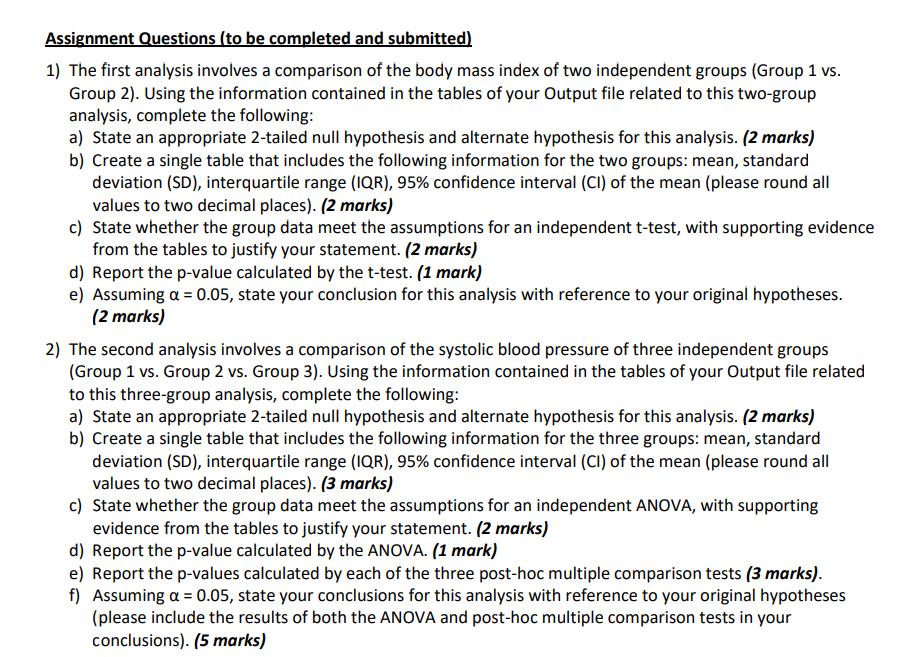



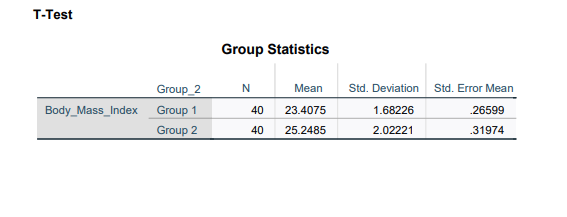
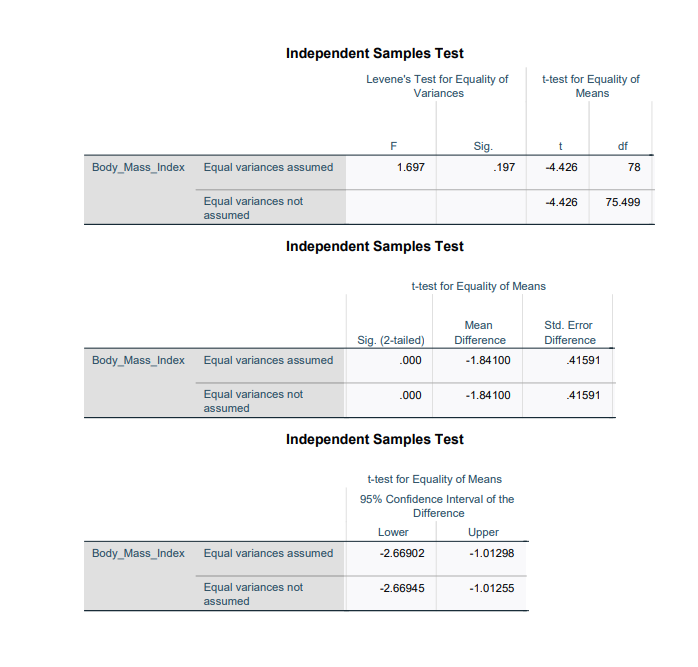
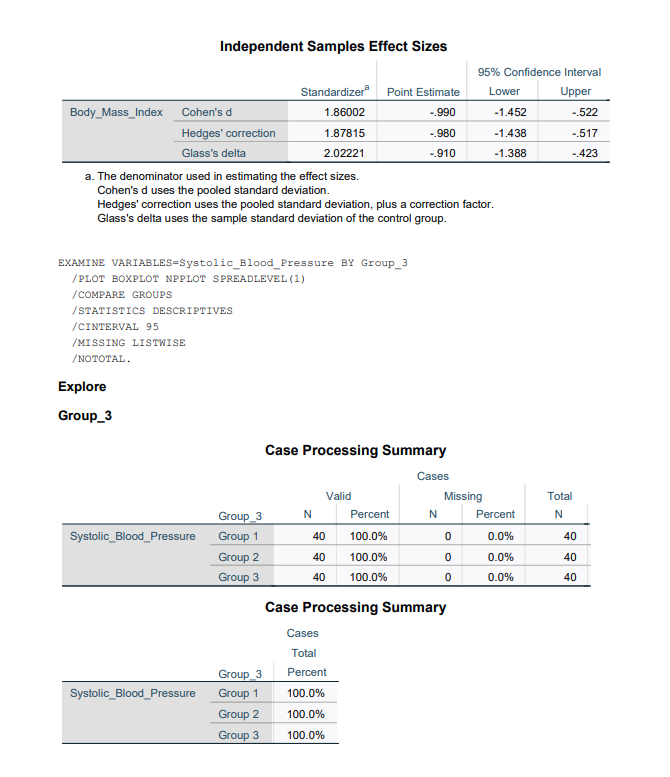
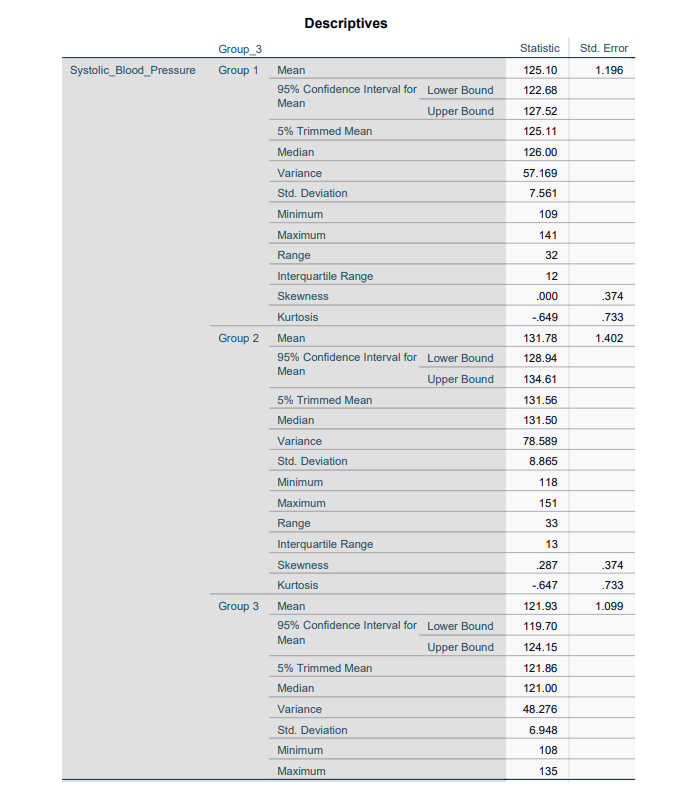
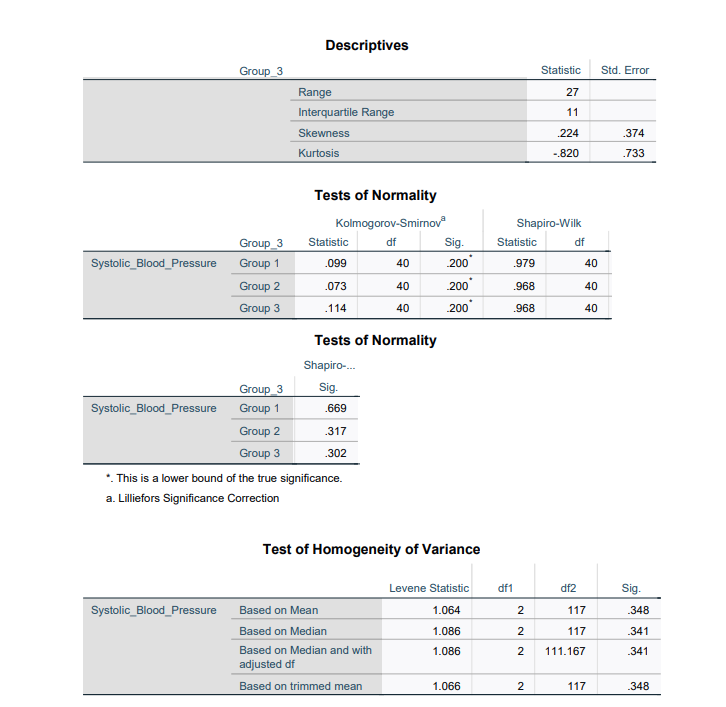
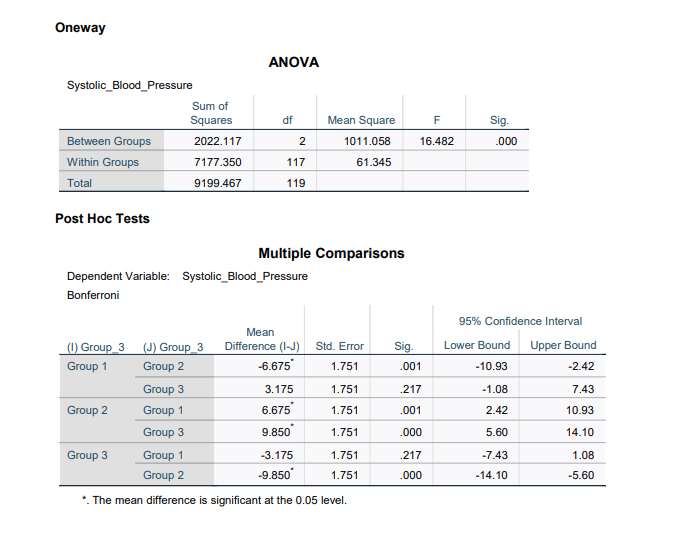
Assignment Questions (to be completed and submitted) 1) The first analysis involves a comparison of the body mass index of two independent groups (Group 1 vs. Group 2). Using the information contained in the tables of your Output file related to this two-group analysis, complete the following: a) State an appropriate 2-tailed null hypothesis and alternate hypothesis for this analysis. (2 marks) b) Create a single table that includes the following information for the two groups: mean, standard deviation (SD), interquartile range (IQR), 95% confidence interval (CI) of the mean (please round all values to two decimal places). (2 marks) c) State whether the group data meet the assumptions for an independent t-test, with supporting evidence from the tables to justify your statement. (2 marks) d) Report the p-value calculated by the t-test. (1 mark) e) Assuming = 0.05, state your conclusion for this analysis with reference to your original hypotheses. (2 marks) 2) The second analysis involves a comparison of the systolic blood pressure of three independent groups (Group 1 vs. Group 2 vs. Group 3). Using the information contained in the tables of your Output file related to this three-group analysis, complete the following: a) State an appropriate 2-tailed null hypothesis and alternate hypothesis for this analysis. (2 marks) b) Create a single table that includes the following information for the three groups: mean, standard deviation (SD), interquartile range (IQR), 95% confidence interval (CI) of the mean (please round all values to two decimal places). (3 marks) c) State whether the group data meet the assumptions for an independent ANOVA, with supporting evidence from the tables to justify your statement. (2 marks) d) Report the p-value calculated by the ANOVA. (1 mark) e) Report the p-values calculated by each of the three post-hoc multiple comparison tests (3 marks). f) Assuming = 0.05, state your conclusions for this analysis with reference to your original hypotheses (please include the results of both the ANOVA and post-hoc multiple comparison tests in your conclusions). (5 marks) Group_2 Case Processing Summary Cases Valid Missing Total Group 2 N Percent N Percent N Percent Body Mass Index Group 1 40 100.0% 0 0.0% 40 100.0% Group 2 40 100.0% 0 0.0% 40 100.0% Descriptives Group_2 Statistic Std. Error Body Mass Index Group 1 Mean 23.4075 .26599 95% Confidence Interval for Lower Bound 22.8695 Mean Upper Bound 23.9455 5% Trimmed Mean 23.3731 Median 23.2650 Variance 2.830 Std. Deviation Minimum 1.68226 20.40 Maximum 27.15 Range 6.75 Interquartile Range 2.42 Skewness .450 .374 Kurtosis -.374 .733 Group 2 Mean 25.2485 .31974 95% Confidence Interval for Lower Bound 24.6018 Mean Upper Bound 25.8952 5% Trimmed Mean 25.1939 Median 25.0000 Variance 4.089 Std. Deviation Minimum Maximum Range Interquartile Range Skewness Kurtosis Tests of Normality 2.02221 21.71 30.10 8.39 3.02 .373 .374 -.472 .733 Kolmogorov-Smirnova Shapiro-Wilk Group 2 Statistic df Sig. Statistic df Sig. Body Mass Index Group 1 .098 40 200 .970 40 .366 Group 2 .094 40 .200 .978 40 .628 This is a lower bound of the true significance. a. Lilliefors Significance Correction Test of Homogeneity of Variance Levene Statistic df1 df2 Sig. Body Mass Index Based on Mean 1.697 1 78 .197 Based on Median 1.610 1 78 .208 Based on Median and with adjusted df 1.610 1 76.365 .208 Based on trimmed mean 1.702 1 78 .196 T-Test Group Statistics Group_2 N Mean Std. Deviation Std. Error Mean Body Mass Index Group 1 40 23.4075 1.68226 .26599 Group 2 40 25.2485 2.02221 .31974 Independent Samples Test Levene's Test for Equality of Variances t-test for Equality of Means F Sig. t df 1.697 .197 -4.426 78 Body Mass Index Equal variances assumed Equal variances not assumed Independent Samples Test t-test for Equality of Means Sig. (2-tailed) Mean Difference Body Mass Index Equal variances assumed .000 -1.84100 Equal variances not assumed -4.426 75.499 Std. Error Difference .41591 .000 -1.84100 .41591 Independent Samples Test t-test for Equality of Means 95% Confidence Interval of the Difference Body Mass Index Equal variances assumed Lower -2.66902 Upper -1.01298 Equal variances not assumed -2.66945 -1.01255 Independent Samples Effect Sizes 95% Confidence Interval Standardizer Point Estimate Lower Upper Body Mass Index Cohen's d 1.86002 -.990 -1.452 -.522 Hedges' correction 1.87815 -.980 -1.438 -.517 Glass's delta 2.02221 -.910 -1.388 -.423 a. The denominator used in estimating the effect sizes. Cohen's d uses the pooled standard deviation. Hedges' correction uses the pooled standard deviation, plus a correction factor. Glass's delta uses the sample standard deviation of the control group. EXAMINE VARIABLES-Systolic Blood Pressure BY Group_3 /PLOT BOXPLOT NPPLOT SPREADLEVEL (1) /COMPARE GROUPS /STATISTICS DESCRIPTIVES /CINTERVAL 95 /MISSING LISTWISE /NOTOTAL. Explore Group_3 Case Processing Summary Cases Valid Missing Total Group 3 N Percent N Percent N Systolic Blood Pressure Group 1 40 100.0% 0 0.0% 40 Group 2 40 100.0% 0 0.0% 40 Group 3 40 100.0% 0 0.0% 40 Case Processing Summary Cases Total Group 3 Percent Systolic Blood Pressure Group 1 100.0% Group 2 100.0% Group 3 100.0% Descriptives Group 3 Statistic Std. Error Systolic Blood Pressure Group 1 Mean 125.10 1.196 95% Confidence Interval for Lower Bound 122.68 Mean Upper Bound 127.52 5% Trimmed Mean 125.11 Median 126.00 Variance Std. Deviation Minimum 57.169 7.561 109 Maximum Range Interquartile Range 141 32 12 Skewness .000 .374 Kurtosis -.649 .733 Group 2 Mean 131.78 1.402 95% Confidence Interval for Lower Bound 128.94 Mean Upper Bound 134.61 5% Trimmed Mean 131.56 Median 131.50 Variance 78.589 Std. Deviation 8.865 Minimum 118 Maximum 151 Range 33 Interquartile Range 13 Skewness .287 .374 Kurtosis -.647 .733 Group 3 Mean 121.93 1.099 95% Confidence Interval for Lower Bound 119.70 Mean Upper Bound 124.15 5% Trimmed Mean 121.86 Median 121.00 Variance 48.276 Std. Deviation 6.948 Minimum Maximum 108 135 Descriptives Group 3 Range Interquartile Range Skewness Kurtosis Tests of Normality Statistic Std. Error 27 11 .224 .374 -.820 .733 Kolmogorov-Smirnov Shapiro-Wilk Group 3 Statistic df Sig. Statistic df Systolic Blood Pressure Group 1 .099 40 200 .979 40 Group 2 .073 40 .200 .968 40 Group 3 .114 40 200 .968 40 Tests of Normality Shapiro-... Group 3 Sig. Systolic Blood Pressure Group 1 .669 Group 2 .317 Group 3 .302 *. This is a lower bound of the true significance. a. Lilliefors Significance Correction Test of Homogeneity of Variance Levene Statistic df1 df2 Sig. Systolic Blood Pressure Based on Mean 1.064 2 117 .348 Based on Median 1.086 2 117 .341 Based on Median and with 1.086 2 111.167 .341 adjusted df Based on trimmed mean 1.066 2 117 .348 Oneway Systolic Blood Pressure ANOVA Sum of Squares df Mean Square F Sig. Between Groups 2022.117 2 1011.058 16.482 .000 Within Groups 7177.350 117 61.345 Total 9199.467 119 Post Hoc Tests Multiple Comparisons Dependent Variable: Systolic Blood Pressure Bonferroni Mean (1) Group 3 (J) Group 3 Difference (I-J) Std. Error Sig. Lower Bound 95% Confidence Interval Upper Bound Group 1 Group 2 -6.675' 1.751 .001 -10.93 -2.42 Group 3 3.175 1.751 .217 -1.08 7.43 Group 2 Group 1 6.675 1.751 .001 2.42 10.93 Group 3 9.850 1.751 .000 5.60 14.10 Group 3 Group 1 -3.175 1.751 .217 -7.43 1.08 Group 2 -9.850 1.751 .000 -14.10 -5.60 *. The mean difference is significant at the 0.05 level.
Step by Step Solution
There are 3 Steps involved in it
Step: 1

Get Instant Access to Expert-Tailored Solutions
See step-by-step solutions with expert insights and AI powered tools for academic success
Step: 2

Step: 3

Ace Your Homework with AI
Get the answers you need in no time with our AI-driven, step-by-step assistance
Get Started


